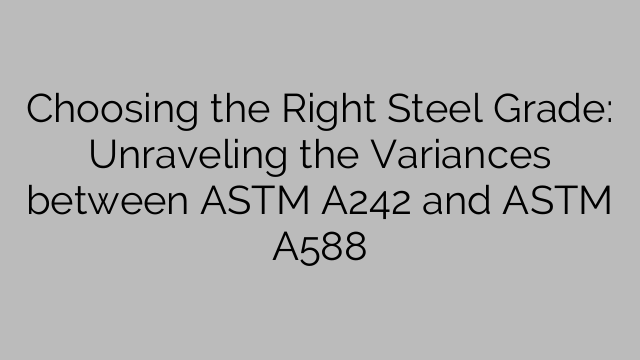When it comes to selecting the appropriate steel grade for a specific application, it is essential to consider various factors such as strength, corrosion resistance, weldability, and cost. Two common steel grades that are often compared are ASTM A242 and ASTM A588. Understanding the differences between these two grades is crucial for making the right choice.
ASTM A242 is a high-strength low-alloy structural steel with improved atmospheric corrosion resistance. It is commonly used in structural applications such as buildings and bridges. This steel grade offers excellent weldability and formability, making it suitable for fabrication purposes. Furthermore, ASTM A242 exhibits good tensile and yield strength, making it a durable option for various construction projects.
On the other hand, ASTM A588 is also a high-strength low-alloy structural steel, but it is primarily designed for use in welded structures and bridges where weight savings and durability are paramount. ASTM A588 is known for its superior corrosion resistance compared to ASTM A242. This steel grade forms a protective oxide layer on its surface when exposed to the elements, preventing further oxidation and corrosion. It is often used in outdoor applications that require exceptional resistance to atmospheric corrosion, such as outdoor sculptures or architectural designs.
The key difference between ASTM A242 and ASTM A588 lies in their atmospheric corrosion resistance. While both grades are suitable for structural applications, ASTM A588 offers superior protection against corrosion due to its higher content of copper, chromium, and nickel. This enhanced corrosion resistance makes ASTM A588 the preferred choice for projects where exposure to harsh weather conditions, such as coastal or highly polluted environments, is a concern.
Another factor to consider is cost. ASTM A588 generally tends to be more expensive compared to ASTM A242 due to its higher alloy content. However, considering its superior corrosion resistance and longer lifespan, the increased initial cost may be justified in certain applications. In contrast, ASTM A242 provides excellent performance at a more moderate price point, making it a cost-effective option for many construction projects.
In summary, choosing the right steel grade between ASTM A242 and ASTM A588 requires careful consideration of the specific requirements of the project. ASTM A242 is a versatile and cost-effective option that provides good overall performance and weldability. On the other hand, ASTM A588 is ideal for applications where superior corrosion resistance and extended lifespan are crucial. Ultimately, consulting with a steel supplier or structural engineer can help determine the most suitable steel grade for a particular project, ensuring optimal performance and longevity.

